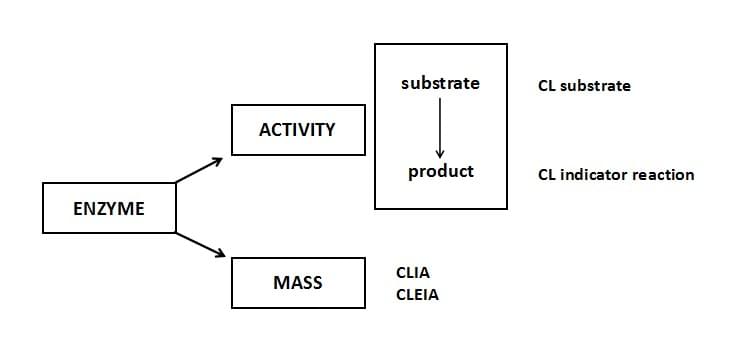Chemiluminescent Enzyme Assays
For years, Creative Enzymes has been performing enzyme assays for research of various purposes. We are committed to being the most reliable service provider of enzyme activity assays in the global market. Today, Creative Enzymes is a leading company in the field of enzyme activity quantitation, especially by luminescent assay which is well known for its high sensitivity. We deliver the test results in the shortest span of time from the date of request submission. The prompt service, best customer care, and dedicated approaches have made Creative Enzymes the most preferred service provider.
Luminescent assays are a common way to monitor an enzymatic reaction, where an enzyme converts a substrate to a reaction product that emits photons of light instead of developing a visible color. Luminescence is described as the emission of light from a substance as it returns from an electronically excited state to ground state. When the excited intermediates return back to their stable ground state, a photon is released, which then can be detected by the luminescent signal instrument or observed by human eyes. The different forms of luminescence (bioluminescence, chemiluminescence, photoluminescence) differ in the way the excited state is reached. For example, photoluminescence is simply fluorescence; the excitation is initiated by light at a particular wavelength. Bioluminescence (BL) is produced by the use of a bioluminescent compound, such as luciferin and firefly luciferase. Chemiluminescence (CL) is light characterized by a chemical reaction. The chemiluminescent substance is excited by the oxidation and catalysis forming intermediates. CL and BL are powerful detection techniques superior to other detection principles involving light, such as fluorometry, due to special features including low noise levels, large detection range, and quick response. They offer the unique advantage that light is emitted by a specific reaction involving the analyte, thus avoiding interference from light scattering and background emission due to sample matrix components. Thanks to the wide dynamic range, samples can be measured over several decades of concentration without dilution or modification of the analytical procedure. Furthermore, the onset of light emission often takes place in seconds or minutes, thus rendering CL/BL techniques very rapid.
 Figure 2: The Chemiluminescent assay strategies for enzymes.
Figure 2: The Chemiluminescent assay strategies for enzymes.
Reference: Kricka L J, Voyta J C, Bronstein I. Methods in enzymology, 1999, 305: 370-390.
The principal advantage of CL enzyme assays is superior sensitivity to conventional spectrophotometric assay methods. Two general types of CL enzyme activity assays have been developed. In the first, an enzyme catalyzes the CL decomposition of a substrate or releases a CL molecule from a specially designed enzyme substrate to produce light emission. The second type of assay uses a CL compound, either directly or indirectly, as an indicator of a reaction between an enzyme and an enzyme substrate.
 Figure 3: Enzyme assay using a 2-methyl-1-propenyl benzoate substrate.
Figure 3: Enzyme assay using a 2-methyl-1-propenyl benzoate substrate.
Reference: Kricka L J, Voyta J C, Bronstein I. Methods in enzymology, 1999, 305: 370-390.
Substantial progress has been made in the design of CL substrates for enzymes, particularly hydrolases. A CL molecule is modified to include a protecting group that is recognized by an enzyme. Enzymatic removal of the group releases a CL molecule or an intermediate that decomposes with the emission of light. Emission intensity, total light emission, or the rate of light emission is measured and related to enzyme activity. The cyclic diacyl hydrazide, luminol, commonly joined with its isomer isoluminol and analogs such as naphthalene-1,2-dicarboxylic acid hydrazides, is a cosubstrate for horseradish peroxidase. It undergoes peroxidase-catalyzed oxidation and the intensity of the glow-type light emission (425 nm) is proportional to peroxidase activity. In recent years, one of the major developments in CL enzyme assays has been the design of families of enzyme substrates based on adamantyl-stabilized aryl-1,2-dioxetanes. In addition, acridan carboxylates, propenyl esters, indoles and imidopyrazines are also used in the CL enzyme assays.
Chemiluminescent assays are available for all of the major classes of enzymes except isomerases and ligases. Generally, CL enzyme assays are more sensitive than colorimetric, fluorimetric, or radiometric assays, and many of the CL assays have subattomole detection limits. The success of CL assays for enzyme labels in immunoassay and nucleic acid assays has been the spur for the continued exploration of different CL reactions with the goal of developing enzyme assays with improved sensitivity, convenience, and versatility. Creative Enzymes well understands the caveats of the CL enzyme assays and offers its clients the best-in-class enzyme activity results.
With decades of research experiences and unique technologies, Creative Enzymes excels with the first-class enzymatic analysis services. Our passion for high quality and unique services is only exceeded by our reputation in the marketplace. Creative Enzymes is your most trustworthy partner whenever you looking for enzyme activity determination using CL enzyme assays.
Related Services
Enzymology Assays
Enzyme Activity Measurement